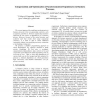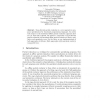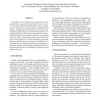142 search results - page 10 / 29 » Program obfuscation: a quantitative approach |
ICDE
2007
IEEE
14 years 9 months ago
2007
IEEE
requirement. Furthermore, programming using sequence constructs normally produce nested structures and The current approachfor modeling synchronization in scattered code, especiall...
ACE
2004
13 years 9 months ago
2004
An examination of some recent programming texts indicates that the complexities of modern programming languages and environments have replaced the study of algorithms and programm...
ASIAN
1998
Springer
13 years 11 months ago
1998
Springer
Abstract. Type-directed partial evaluation is a new approach to program specialization for functional programming languages. Its merits with respect to the traditional offline part...
ICMCS
2006
IEEE
14 years 1 months ago
2006
IEEE
We compare three Computer Vision approaches to 3-D reconstruction, namely passive Binocular Stereo and active Structured Lighting and Photometric Stereo, in application to human f...
CJ
2010
13 years 5 months ago
2010
Abstract. Semantics-based program analysis uses an abstract semantics of programs/systems to statically determine run-time properties. Classic examples from compiler technology inc...



